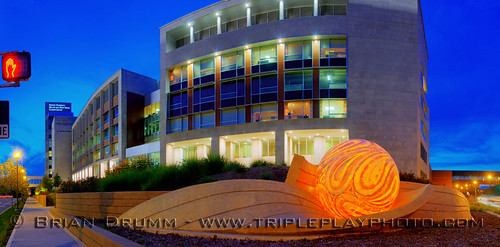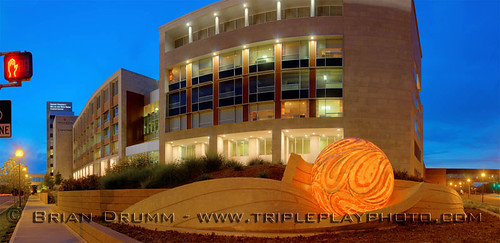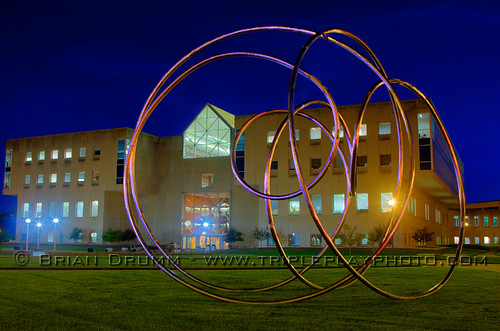I've been an HDR (High Dynamic Range) photography enthusiast for about a year now. Having now done hundreds, or may be even thousands, of bracketed exposure sets, I'm always on the lookout for ways to reduce the tedium of this exercise. Auto-exposure bracketing would seem to be the answer, but, if this post can be seen as an open letter to Canon, Inc., I would have to begin it thusly:
"Dear Canon,
Your Auto Exposure Bracketing sucks."
For cameras other than the EOS 1D's, (like my 5D and 40D) one can set bracket inervals up to two f-stops for up to 3 exposures. This is sufficient only for what the book I consider to be the
Bible of HDR imaging calls "MDR," or medium dynamic range. It's sufficient for many of the images I have taken (including the one that serves as the banner to this blog), but certainly not all situations. The pro-level Canon 1D mark III will do up to 7 exposures at up to 3 f/stop intervals. That's much better, if you can afford the price of admission.
I was frustrated enough with the lack of Canon bracketing options that I looked into Nikon cameras. (Switching to Nikon is not something I would seriously consider for multiple reasons, but I looked anyway.) Sadly, Nikon's AEB features didn't strike me as being much better. The Nikon D300 and D700 (to name the only two cameras I have looked at), do up to 9 exposures at up to 1 f/stop intervals. Bracketing over the 9 stop range would be great, but the 1 f/stop interval limit would not be my preference. I've found that 2 f/stop bracket intervals is quite sufficient for HDR work, and the 1 f/stop intervals from the Nikon would fill up my card with a lot of data that I would never use.
There are a few possible workarounds to this:
One option would be to connect the camera to the laptop via USB cable and control it that way. I suspect the brackets could be automated, either in the Canon EOS Utility software or via other means using the Canon SDK (software development kit). I "applied" to receive the SDK last Friday, and haven't yet been notified if I will be one of the "cool kids" and be granted download of the kit. Another open question is whether I will be able to figure out how to actually make the SDK do something more constructive than take up hard disk space. I am a scripter (using AppleScript), but am by no means a software engineer.
But even if I can get an SDK solution to work, I'm not sure at all that I want to lug a laptop around while I shoot, which I sometimes do in inclement weather. Seems to me that would just be a different kind of hassle, not a solution to the the problem. So let's leave this idea aside and proceed to. . .
Arduino.
This is something I just learned of recently thanks to the
This Week in Photography podcast.
Arduino is a small circuit board that can be programmed from your computer when connected by a USB or serial cable and running a programming environment on Mac, PC, or Linux. I was briefly enthused by this idea,
described here, which makes use of software, called Bracketmeister, engineered by a highly skilled photographer named Joergen Geerds (his
blog, his
portfolio). But then I realized that it operated the camera in "Bulb" mode, which means shutter speed accuracy at speeds shorter than 1 second would be dicey at best, if even possible. Many of my brackets run up into the 1/8th second range, and there is one lighted bank sign on the Indianapolis downtown skyline that is so bright it can take up to 1/60th second to keep it from burning out. (Thanks for that, Fifth Third bank.)
The Arduino board is interesting to the budding electronics geek in me and I will probably mess with it at some future time for another purpose, but it does not seem like the preferred solution for my bracketing needs.
Another possible solution I know I am not the first to think of would be using iPhone or iPod Touch as a handy, portable device for camera control. But my understanding is that these devices are "locked out" of any kind of tethering operation with non-Apple devices. And again, this would probably require programming chops I do not possess, this time with the Apple iPhone SDK.
So, for now, it looks like I'm limited to counting the clicks on the shutter speed wheel in the dark. The best approach I've found thus far is to use a combination of AEB and manual adjustments.
Here are the particulars: My cameras are set to vary the exposure settings in 1/2 stop intervals instead of the default 1/3 stop interval. This gives me the most exposure variation "per click." I first determine the minimum shutter exposure that I plan to use for my brackets by reducing exposure until the brightest area of the image no longer flashes a highlight warning on the LCD. Then I set up AEB at 1.5 stop intervals, and slow the shutter speed down by 3 clicks. This gives me a 3-exposure set with my pre-determined minimum exposure at the low end. This is not yet a high enough exposure range, of course. So I then slow the shutter speed by 9 more clicks of the Tv wheel and do another 3 exposure set. This results in 6 exposures at 1.5-stop intervals for a 7.5 stop range.
That's still more clicks than I like to count, and results in touching the camera on the tripod more than I would like. But it does yield the broadest exposure range for least tedium of any method I have found so far.
 Here are two more HDR's from last Saturday night, this time of the Melvin and Bren Simon Cancer Center, part of the Indiana University School of Medicine in Indianapolis, IN. In the case of the photo above, I set the white balance on the camera to the Tungsten setting, although often I will set the white balance with a gray card based on whatever weird lighting is on the scene.
Here are two more HDR's from last Saturday night, this time of the Melvin and Bren Simon Cancer Center, part of the Indiana University School of Medicine in Indianapolis, IN. In the case of the photo above, I set the white balance on the camera to the Tungsten setting, although often I will set the white balance with a gray card based on whatever weird lighting is on the scene.




